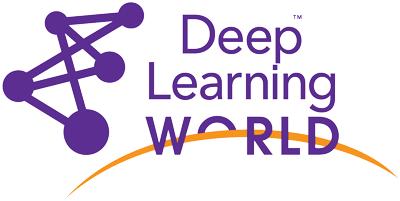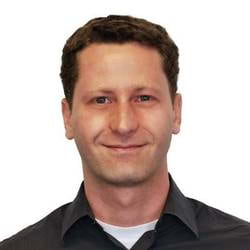THIS PAGE PERTAINS TO LAST YEAR’S EVENT.
Sign up for our DLW Updates to receive the latest news on the 2019 event.
Agenda
Deep Learning World Las Vegas 2018
June 3-7, 2018 – Caesars Palace, Las Vegas
This page shows the agenda for Deep Learning World. Click here to view the full 7-track agenda for the five co-located conferences at Mega-PAW (Deep Learning World plus 4 Predictive Analytics Worlds: PAW Business, PAW Financial, PAW Healthcare, PAW Manufacturing).
See also other available pre/post-conference training workshops on other analytics topics (not on deep learning): June 3rd, 4th, and 7th
Workshops - Monday, June 4th, 2018
Full-day: 8:30am – 4:30pm
This one-day introductory workshop dives deep. You will explore deep neural classification, LSTM time series analysis, convolutional image classification, advanced data clustering, bandit algorithms, and reinforcement learning. Click workshop title above for the fully detailed description. Click workshop title above for the fully detailed description.
Deep Learning World - Las Vegas - Day 1 - Tuesday, June 5th, 2018
Applied deep learning has fast become a standard tool for many industry machine learning applications. New advances in neural network techniques have opened the doors to solving problems at scale that were out of reach until recently. Because of these advances, applications such as in image recognition for self-driving cars, medical image classification, text translation, and fake news detection are both tractable and often the industry standard. In this keynote, Mike Tamir, who heads the data science teams at Uber ATG—the self-driving cars division—reveals how two key application areas of deep learning signal the broad importance of this emerging technology.
Data science, if judged as a separate science, exceeds its sisters in truth, breadth, and utility. DS finds truth better than any other science; the crisis in replicability of results in the sciences today is largely due to bad data analysis, performed by amateurs. As for breadth, a data scientist can contribute mightily to a new field with only minor cooperation from a domain expert, whereas the reverse is not so easy. And for utility, data science can fit empirical behavior to provide a useful model where good theory doesn’t yet exist. That is, it can predict “what” is likely even when “why” is beyond reach.
But only if we do it right! The most vital data scientist skill is recognizing analytic hazards. With that, we become indispensable.
DataRobot will demonstrate how innovations in Machine Learning & Artificial Intelligence can easily be leveraged to address a variety of opportunities and challenges across industries. Today, companies now have the ability to use machine learning & AI as a competitive advantage in their market, reduce operational costs, create new revenue streams, and drive higher customer satisfaction and loyalty. DataRobot's presentation will outline how scaling AI across your enterprise will deliver top & bottom line-benefits...create truly an "AI-Driven Enterprise".
Groundbreaking theory, big data, and compute power — with this trifecta, the extraordinary advent of deep learning seems almost inevitable. It propels machine learning to new heights across many industries. As we ride this wave of progress, still in acceleration, we come to a new class of challenges akin to those of traditional machine learning — but now the stakes are higher. In this keynote, DLW Founding Chair Luba Gloukhova will cover great challenges deep learning has already overcome and those that still remain.
Senior Scientist Engineer at Microsoft, James McCaffrey and Pranjal Daga, Data Scientist at Cisco, will field questions from the audience of deep learning practitioners about all things deep learning deployment, from initial research and development to championing within the organization to scaling up for production and maintaining.
In the field of Automatic Speech Recognition (ASR), the state of the art for generic conversations have reached super human levels. However, things are not nearly as good in specialized knowledge domains: attempting to transcribe vendor-customer or intra-vendor conversations often results in high double-digit error rates. Considering the low performance of ASR on real data, it becomes imperative to look at the multimodal data of text and images to customize the Language Model, and audio to customize the Acoustic Model. This session will focus on discussing end-to-end Recurrent Neural Network architectures which can learn alphabets just through a sound spectrogram.
High frequency trading (HFT) has been characterized as an arms race with 'Red Queen' characteristics. And yet, Machine Learning (ML) has barely impacted HFT. Indeed, its application raises more questions than it answers. How do we integrate an agent's actions into a predictive model? If all agents use ML, then why trade? This talk demonstrates a novel model for attributing strategy performance to predictive accuracy. Our model quantifies the extent to which an agent's action invalidate the prediction. Moreover, the model sheds light on why a zero-sum game is an unlikely outcome for ML agents.
Long short-term memory (LSTM) deep neural networks have revolutionized natural language and are the foundation of systems like Siri and Alexa. Because LSTM networks maintain state, they can model time series regression problems. In this lively and informal session, Dr. James McCaffrey from Microsoft Research will explain exactly what LSTM networks are, without using (many) Greek letters or annoying math jargon. You'll leave this session with a solid understanding of LSTM networks, know what they can and cannot do, and have all the information you need to implement an LSTM network or communicate with subject matter experts.
Deep Learning World - Las Vegas - Day 2 - Wednesday, June 6th, 2018
Domain generation algorithm malware makes callouts to unique web addresses to avoid detection by static rules engines. To counter this malware, we created an ensemble model that evaluates if domains are malicious. The ensemble consists of two deep learning models a convolutional neural network and a long short-term memory network. These deep networks are flexible enough to learn complex patterns and do not require manual feature engineering. Our system analyzes enterprise-scale network traffic in real time. This talk will discuss the machine learning algorithms that were used to build the model and the model-as-a-service architecture utilized for low-latency processing.
Head of Lyft's Machine Learning Platform Gil Arditi and Seagate Technology Senior Data Scientist, Melanie Beck field questions from an audience of deep learning practitioners about all things deep learning deployment, from initial research and development to championing within the organization to scaling up for production and maintaining.
AlphaGo, AlphaGo Zero, Alpha Zero Chess. One might wonder what’s next. AI and Deep Learning (DL) seem more like interesting research topics. Adoption into mainstream enterprise seems some ways out. John Hancock approaches DL as an opportunity to potentially disrupt its traditional model building process wherein the DL algorithms start without any prior business knowledge. In this session, you will learn about the journey of (NLP and) DL using two use cases – to detect fraudulent patterns and in predicting Underwriting Risk Class. We will also discuss a broader range of opportunities for DL application in financial services. In all cases, our starting point is (text) unstructured data.
Recent rapid developments in Machine Learning (ML) and Neural Networks (NN) have outstripped the capability of most programming languages to cope with the enormous volume of new technology and concepts. This has made understanding and use of these new paradigms very difficult for all but the computing cognoscenti. The solution is the high level symbolic/numeric hybrid Wolfram language that provides functional tools for top level Classification and Prediction as well as lower level construction of the neural network layers that form the basis of ML algorithms today.
With the rise of deep learning as a promising solution in the area of object detection and image recognition, industries are embracing Convolution Neural Networks (CNN) in many applications such as autonomous cars, security surveillance, medical imaging, etc. This presentation will showcase how Seagate is refining its Industrial Internet of Things (IIoT) strategy by developing and deploying CNN algorithms in its factories. From product quality check to security surveillance, deep learning is helping shape the digital transformation of Seagate Technology operations by boosting the performance of deployed machine learning models to unprecedented accuracies.
Like many companies, Northwestern Mutual switched from being paper-based to relying on "electronic forms" for underwriting health surveys. While this vastly improved underwriting processes, extraction of historical "paper-based" data is still desired to unlock its business value. Learn how Northwestern Mutual, on its journey to algorithmic underwriting, successfully extracted data from scanned health surveys by leveraging computer vision and deep learning.
As Deep Learning tools and frameworks become more prevalent and lower the complexity of the development process, we see a shift in data-driven software development towards using Deep Learning instead of classical ML or more standard software. This change entails a different software development process that affects the way we frame the problem, iteratively develop the solution, allocate and manage compute and memory resources, and debug our system. The talk will cover the shift in some areas from classical software development to Deep Learning, success stories of employing Deep Learning, the organizational processes and required developer skills needed, and insights on how to best manage the entire model lifecycle - from ideating to deployment and maintenance.
4:15 pm - 5:00 pm
One in six children suffer from developmental delay. In many cases,early screening is possible using behavioral phenotypes. We showcase the use of interactive storytelling sessions on tablets to collect video feeds for automated screeners powered by deep learning.




















